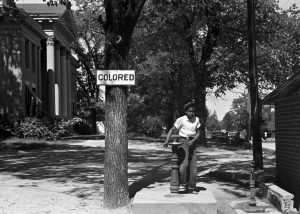While Brown v Board was officially signed in 1954, the actual effects of the law were not felt until many years after, as state officials continued to bar black students from entering prior established white schools. White people used many fear tactics to keep black students out of the ‘white only’ schools. For example, they would send death threats to black students, throw rocks into black families’ homes, set fire to their homes and even bomb their homes. Acknowledging the disinterest of many states in the U.S to integrate their schools, “the Supreme Court did not immediately try to give direction for the implementation of its ruling,” (uscourts.gov). With the Supreme Court not giving direct implementation for states on how to reintegrate their schools, they left it up to the states to decide how they wanted to go forward with this new law. By allowing states to decide, the implementation of Brown v Board was further delayed and students of color continued to receive lower quality education. While the Supreme Court made history with its passing of Brown v Board, they are at fault for the continued racial segregation of schools for years after the law was passed because they refused to enact a federal mandate establishing an exact order of how all states would desegregate their schools. Leaving decisions up to the states has long been a part of U.S’s history struggling with racial tensions. The southern states of the U.S have always fought for states’ rights since Lincoln declared he would abolish slavery. Understanding this historical context, the Supreme Court should have exercised its powers more diligently and not left reintegration of schools up to the states.
By allowing the states to decide how they wanted to implement integration in schools, achieving equal education became even more turbulent. Black people understood that if the Supreme Court passed a law to integrate schools, then they should be guaranteed that right to attend whatever school they wished. However, when many black students attempted to enter into previously established white only schools, opposers took to vigilante justice. Black students were threatened with violence if they tried to attend previous white only schools. In many cases, threats turned into actual violence, “white resistance to school desegregation resulted in open defiance and violent confrontations, requiring the use of federal troops in Little Rock, Arkansas, in 1957,” (Library of Congress, 2004). As Michael J. Klarman points out in his article on the court decision, “But Brown may have mattered even more in an unexpected way: it helped ensure than when protests, sit-ins, and freedom rides came to the South in the 1960s, politicians such as Bull Connor and George Wallace were there to meet them with violence,” (Klarman, 2004). This mean that unintentionally, Brown v Board revealed more racist sentiments and violent action from the opposers than before it was passed. The day the law was enacted, people labeled the day as Black Monday because “white citizens’ councils formally organized throughout the south to preserve segregation and defend segregated schools,” (Library of Congress, 2004). Just as Trump’s election has elicited more racial and sexist aggression in the U.S, Brown v Board led to a further divide in the American educational system. Similarly to Trump as well, “Although most southern politicians avoided explicit exhortations to violence, they used extremist rhetoric that encouraged it,” (Klarman, 2004). In many southern cities, racial violence and oppression was worse than before Brown was passed, just as in Alabama, “Birmingham’s racial progress ground to a halt,” (Klarman, 2004). White people feared that black students would interfere with their children’s education and therefore used all attempts to reverse this court order. White opposer groups to racial integration of schools went so far as to “call for the nullification of the NAACP, the creation of a forty-ninth state for Negroes, and the abolition of public schools,” (Library of Congress, 2004). All these tensions between whites and blacks after the passing of the law in 1954 created a negative environment for anyone but white people to attend school in. The white opposition to school integration caused fear and panic for blacks in America and led to further segregation of schools because even with a federal law, many blacks valued their lives over education and remained in their poor, underfunded schools rather than risk white hostility.
References:
History – Brown v. Board of Education Re-enactment. (n.d.). Retrieved March 09, 2018, from http://www.uscourts.gov/educational-resources/educational-activities/history-brown-v-board-education-re-enactment
Klarman, M. J. (2004, March & april). Brown v. Board (50 Years Later). Retrieved March 09,
2018, from https://www.neh.gov/humanities/2004/marchapril/feature/brown-v-board
